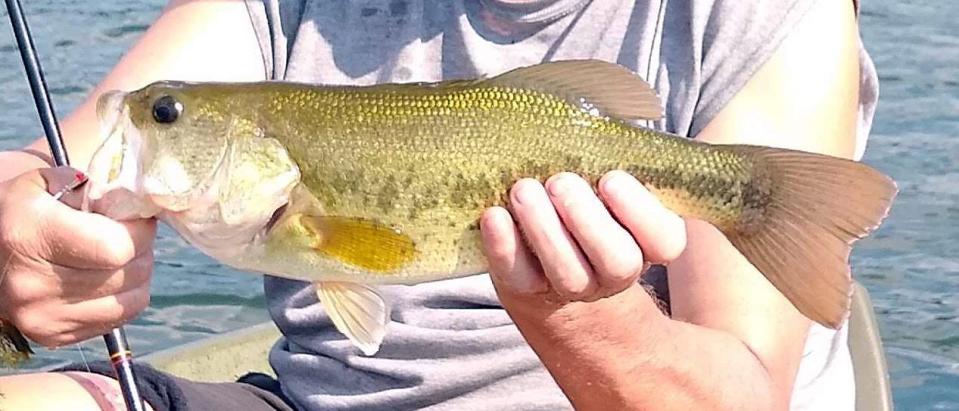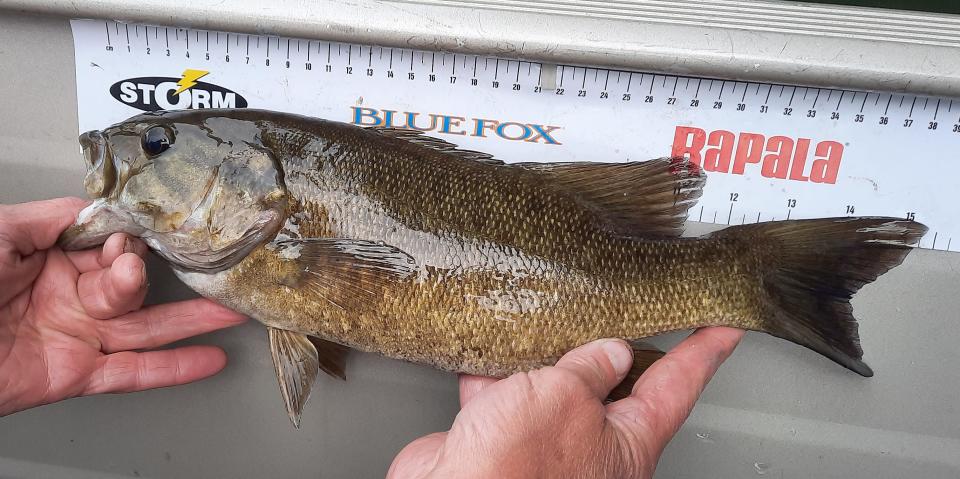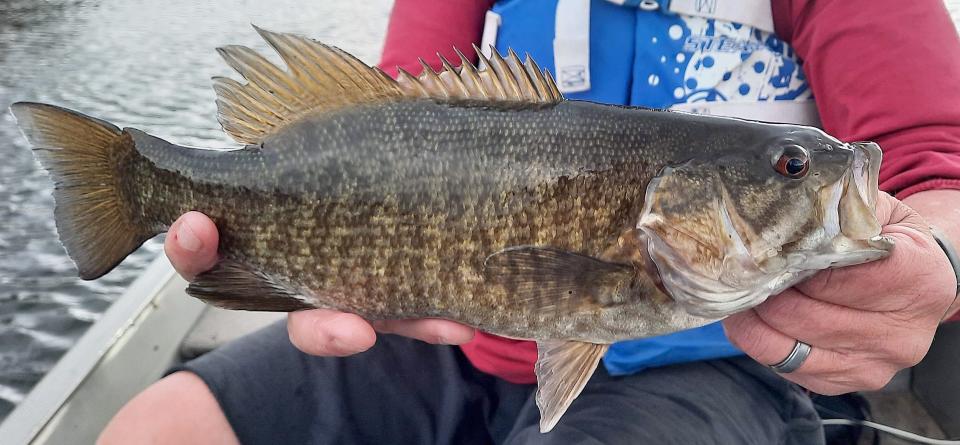Looking for bass in Pennsylvania? Here's how and where to find them
There are plenty of lakes and rivers to explore across Pennsylvania as bass season begins this week.
Smallmouth and largemouth bass are plentiful across the 86,000 miles of rivers and lakes in Pennsylvania, and anglers know these predator fish are fun to catch.
The summer bass season runs June 10-Sept. 30 in Pennsylvania, and anglers are allowed to creel six fish a day that are at least 12 inches long. Starting Oct. 1, anglers are able to keep four bass that are at least 15 inches long. April 8-June 9 is a catch-and-release only period.
Some waterways have special regulations, including the Big Bass Program and catch-and-release only waters.
Under the Big Bass program, the regulations on those waterways allow four bass that are at least 15 inches to be creeled between Jan. 1 through April 8, and June 11 through Dec. 31.
Bass are opportunistic creatures in that they will eat a wide variety of foods. From crayfish, to minnows, large worms, frogs, and large crickets, there’s very little that a hungry bass won’t try to consume. If you like artificial baits, soft plastic versions of hellgrammites and worms placed at the end of a weighted jig will usually get the job done. That’s what’s nice about bass fishing. The fish are curious and like to eat a wide variety of foods or aquatic imitations. If there’s lots of structure, tree branches and weeds, a top water lure is a good go-to option to avoid the snags.
If weeds and debris are not too heavy, a variety of spinners, spoons and plastic minnow combinations work well as they imitate bait fish.
Some of the most known waterways for fishing in Pennsylvania include the Susquehanna River in eastern Pennsylvania, Raystown Lake in central Pennsylvania, and Lake Erie, Presque Isle Bay and the Pymatuning Reservoir are western travel destinations for many people who want to find large numbers and sizes of bass.
However you don’t have to travel far in Pennsylvania to catch nice fish.
The Pennsylvania Fish and Boat Commission’s website has an interactive map about various places to fish, but here are some of the places that are regarded as top fishing waters for largemouth and smallmouth bass.

Large reservoirs
Lake Erie in northwestern Pennsylvania is known for all types of fishing. From smallmouth bass, to steelhead and lake trout to walleye and perch, you can’t go wrong here. It’s the fourth largest of the five Great Lakes and offers every kind of water condition an angler desires.
Presque Isle Bay off Lake Erie is a nationally renowned fishery in Erie's Presque Isle State Park. The peninsula forms a bay similar to a seashore found at the ocean. Anglers catch both small and largemouths as they swim to the shore line from the deeper waters. There are four launch areas that accommodate a wide variety of watercraft.
Lake Wallenpaupack in northeastern Pennsylvania has 52 miles of shoreline to find the bass hot spots. It encompasses 5,700 surface acres of water in Pike and Wayne counties. The PFBC reports it is owned by Brookfield Renewable and operated as an auxiliary electric generating facility. It is open to the public for recreation purposes like fishing, boating and waterskiing. There is no horsepower limit for boaters, but boats are limited to 45 miles per hour from sunrise to sunset on weekends and holidays from the Saturday before Memorial Day to Labor Day. Boats are also limited to 25 miles per hour between sunset and sunrise.
Lake Wilhelm is a 1,680-acre lake in Maurice K. Goddard State Park in Sandy Lake, Mercer County. Boats up to 20 horsepower are permitted, and the waterway is known for having wetlands.
Marsh Creek Lake can be found in north central Chester County in Marsh Creek State Park. It’s a 535-acre lake that welcomes electric-powered boats from its two launch areas. There’s a nice breeze on the lake making it attractive to sailboats.
Nockamixon Lake, part of the Nockamixon State Park, is found in eastern Pennsylvania's Bucks County. It’s a 1,450-acre lake popular with migrating birds. Boats with gas motors up to 20 horsepower are welcome to launch from five parts of the lake.
Raystown Lake in Huntingdon County is the place to go for big water in the central part of the state. It’s an 8,300-acre reservoir managed by the U.S. Army Corps of Engineers. It’s common to see kayaks to massive yachts floating on this waterway. It’s the largest body of water with all of its borders in Pennsylvania. It holds large populations of both smallmouth and largemouth bass.
Yellow Creek Lake is part of Yellow Creek State Park in Penn Run, Indiana County. The lake is 720 acres and supplied with water from Yellow and Little Yellow creeks. There are four launch areas, and the waterway accommodates boats up to 20 horsepower gasoline motors.
What you need to know: Three experts highlight best opportunities to catch bass in Pennsylvania
Stay safe on the water: Two boating fatalities in 2023. What happened? How can you avoid an accident?
Explore Pennsylvania: 2 million acres, 8 forests. It's all in the Pennsylvania Wilds.
Let's go fishing: Here's where anglers are catching the largest fish across Pennsylvania

Medium reservoirs from 50-500 acres
Cross Creek Lake in Washington County is a 244-acre Big Bass Program lake in southwestern Pennsylvania. Boats are limited to 10-horsepower motors. It’s owned by the Washington County Department of Parks and Recreation, and the PFBC points out anglers should be aware that an annual use permit, which can be obtained from the Department of Parks and Recreation office, is required for all boaters using the lake, launch ramp, and courtesy docks.
Green Lick Reservoir is a 101-acre lake in Fayette County. It’s managed by the PFC with an electric-motor-only regulation for boats. There’s one launch ramp to access the waterway.
Lackawanna Lake in northeastern Pennsylvania is regulated by the Big Bass program. Located in Lackawanna State Park, near Scranton, the 198-acre impoundment is 2.5 miles long, giving anglers more than 7 miles of shoreline to consider.
Pinchot Lake in northern York County, also in the state’s Big Bass program, is 340 acres found in the center of Gifford Pinchot State Park and built for recreation. Power boats must have electric motors, but there are 286 shoreline mooring and canoe rack spaces available. It’s also a good place to see sailboats while fishing.
Shawnee Lake is located in the heart of Shawnee State Park in Bedford County, bordering Maryland. It’s included in the Big Bass program. It’s a 451-acre lake with three boat launches for watercraft limited to electric motors. It’s known for both small and largemouth bass opportunities.
Small reservoirs, less than 50 acres
Hamilton Lake is a 42-acre lake near Wellsboro in Tioga County. If you’re traveling, it’s worth your time to see Pennsylvania’s Grand Canyon that’s just a short distance away.
Mammoth Dam in Westmoreland County is a Big Bass Program waterway. Located near Mount Pleasant, this 24-acre lake proves you don’t need a lot of water to find a lot of bass. Only non-motorized kayaks and canoes up to 16 feet in length are permitted

Flowing waters
The Allegheny River starts in Pittsburgh, and anglers can fish 325 miles of stream as it flows into New York and back into Pennsylvania.
The Clarion River is actually a tributary of the Allegheny River, flowing 110 miles in west central Pennsylvania. It’s a popular waterway for those who like fishing from canoes and kayaks. There are recreational stops along the river as it flows near Cook Forest State Park, Clear Creek State Park, the Allegheny National Forest, Bendigo State Park and Elk State park. It’s the place to have a true wilderness adventure while catching smallmouth bass.
French Creek is another tributary of the Allegheny River in northwestern Pennsylvania. The 117 miles of river is known as a biologically diverse waterway with more than 80 species of fish.
Juniata River is the hotspot in central Pennsylvania for smallmouth bass. It flows 104 miles through wilderness and mountain areas as a tributary to the Susquehanna River. In the summer months, you will want to check on the water level as the PFBC reports it may sometimes be too shallow for your watercraft. There is a catch-and-release regulation for part of the river. From Port Royal downstream to the mouth, including all tributaries to a point 1/2 mile upstream from the confluence in Dauphin, Juniata and Perry counties is catch and release for both smallmouth and largemouth bass.
Susquehanna River is one of the main waterways in eastern Pennsylvania, from New York through Pennsylvania and into Maryland. It’s a wide but shallow waterway that provides excellent habitat for smallmouth. There are some special regulation areas. From the inflatable dam near Sunbury downstream to Holtwood Dam, including all tributaries to a point 1/2 mile upstream from the confluence in Cumberland, Dauphin, Juniata, Lancaster, Northumberland and Perry counties is catch and release for smallmouth and largemouth bass.
The Youghiogheny River flows from Somerset County to Pittsburgh in southwestern Pennsylvania. The 134-mile river is a tributary of the Monongahela River. There’s a flood control dam located in Confluence that is designed to keep the river from flooding Pittsburgh. While on the river it’s common to see whitewater rafters. There are various rock formations and diverse habitats that make the stream a destination for anglers and boaters.
This listing is a good start to find places where you can catch bass, but it’s far from a complete list. From local farm ponds and small reservoirs, bass are plentiful across the state. Now is the time to get out there and find those trophy fish.
Brian Whipkey is the outdoors columnist for USA TODAY Network sites in Pennsylvania. Contact him at bwhipkey@gannett.com and sign up for our weekly Go Outdoors PA newsletter email on this website's homepage under your login name. Follow him on Facebook @whipkeyoutdoors,Twitter @whipkeyoutdoors and Instagram at whipkeyoutdoors.
This article originally appeared on Erie Times-News: Where can you catch bass in Pennsylvania

